The concept of subscriptions has been around for centuries, originally as the means of delivering fresh dairy products, groceries, and newspapers to your doorstep – and gradually working its way into other industries. Today, its penetration is enormous. A whopping 98 percent of respondents to a 2021 survey have at least one paid video streaming subscription. Millennials in the US reportedly have 17 entertainment subscriptions each. It seems nothing but convenient to set up an auto-payment and get cable or streaming services, ready-made meals, beauty products, gym membership, co-working spaces, online education, hotel discounts, insurance, you name it.
Needless to say, this trend creates immense business opportunities for companies from different sectors – travel included. Consider this: Zuora’s Subscription Economy Index™ (SEI) report calculated that subscription businesses in the index have outpaced S&P 500 growth rates by 4.6x over the past decade.
And if we look at traveler sentiment, another 2022 research has shown that a combined 87 percent of travel subscribers plan to increase (47 percent) or maintain (40 percent) their current travel subscription levels. So today, we discuss how travel companies can implement a subscription model to capitalize on modern trends and boost revenue.
What is a travel subscription?
A travel subscription is a recurrent fee charged by a travel business monthly or annually for providing access to various exclusive products, discounted deals, cashback, and other perks. In most cases, this recurrent fee is charged automatically from a user’s linked credit card (which makes subscriptions different from other regular payments such as rent).
Such an approach can be beneficial for almost any travel company, including airlines, hotels, vacation rentals, travel agencies, tour operators, and so on.
Before we go deeper into business model types and examples, let’s look at the travel subscriptions classification.
Types of travel subscriptions
One of the ways we can look at travel subscriptions involves dividing them into two categories: trip subscriptions and membership clubs.

Travel subscription types
Trip subscriptions involve a fixed fee paid to get travel products (flights, hotel nights, cars for rent, etc.) for free or with minor additional charges like taxes. In this case, the fee is usually higher, but this type increases travelers’ loyalty as they only use the products of the company they subscribed to to avoid wasting their allowance. Another benefit is that the travel company reduces marketing and sales costs.
Trip subscriptions can be further divided into
- limited subscriptions which involve accruing a set number of travel products per month that replenishes with the next payment, and
- unlimited subscriptions which allow travelers to use as many travel products as they want.
Note that there are almost no truly unlimited deals because travel companies still pose a number of restrictions either on the bookable inventory or the booking conditions (e.g., only last-minute booking, only certain room types, no booking within certain dates of high season, etc.).
Membership clubs involve paying a fee to get discounts and/or other ancillary services (e.g., 20 percent off any flight booking, extra baggage allowance, priority check-in, complimentary meals, etc.).
Such subscription programs have less influence on the traveler's choice of who to book with than the previous category, but since they usually cost way less, they are likely to attract a greater number of members – thus increasing the company’s customer reach.
Subscription and membership models in travel
To get the fullest picture, let’s draw a line between several concepts that might seem similar and have some overlaps but essentially mean different things, i.e., closed user groups, timeshares, vacation/travel clubs, loyalty programs, and subscriptions.
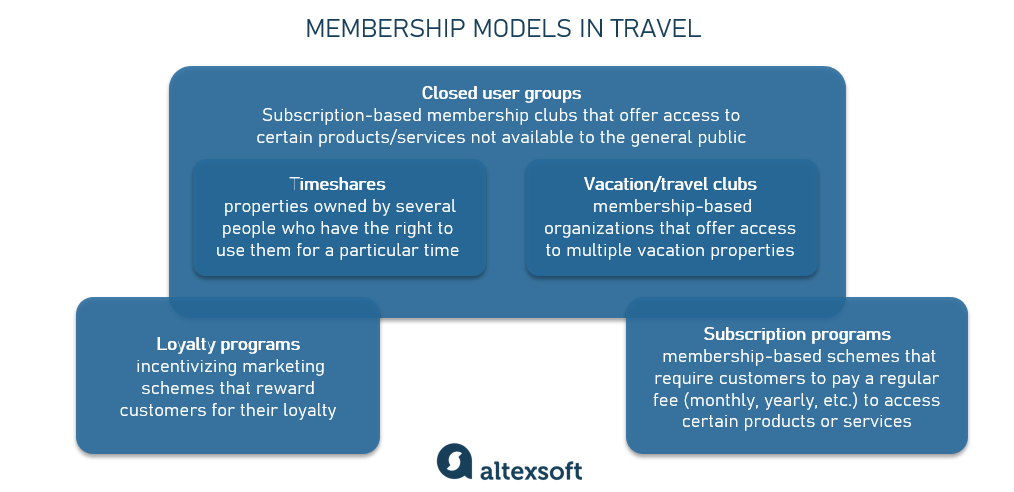
Travel membership models compared
Closed user groups are a broad concept that might be an umbrella term for subscription-based membership clubs. In general, they offer their members access to certain products or services not available to the general public, thus providing a sense of belonging and exclusivity. Typically, they are organized around a specific theme (e.g., luxury travel) with members meeting certain demographic/lifestyle criteria (e.g., retirees, families, members of a sports club) and/or meeting certain loyalty or engagement criteria.
Timeshares are properties that are owned by several people who have the right to use them for a particular time. Such properties are often located in popular vacation destinations, so people get involved in this kind of co-ownership to have their own place to stay in preferred locations. Learn more about timeshares and their evolution from our video.
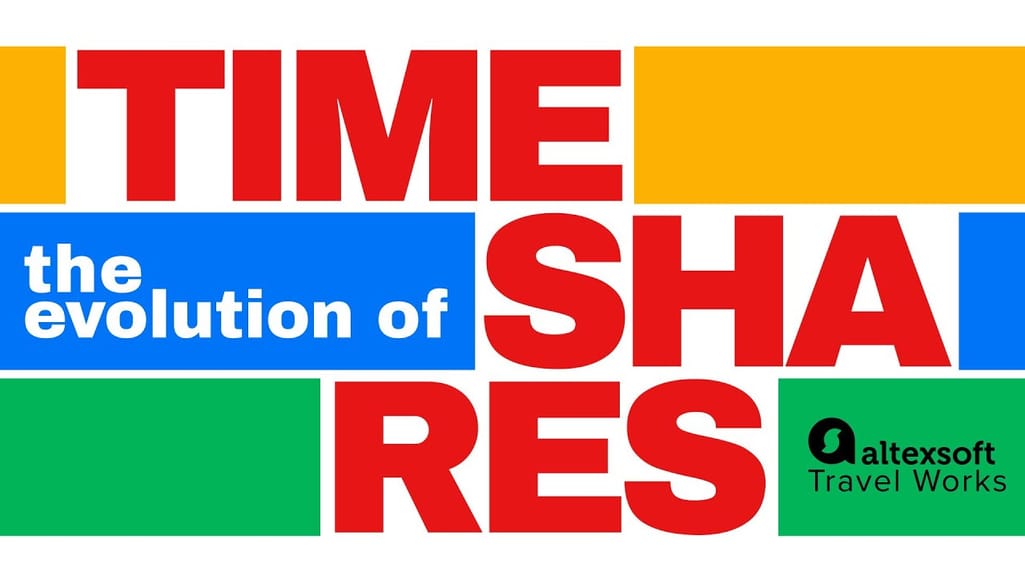

What timeshares are
Vacation clubs are often used interchangeably with timeshares (as they essentially evolved from timeshares), though they are not the same. These are membership-based organizations that offer access to multiple vacation properties in various destinations. However, unlike timeshares, they don’t confer ownership. After paying an initial fee, members can book any property from its inventory pool for a desired period of time.
Travel clubs are mostly used as a synonym for closed user groups or vacation clubs. Sometimes, they can also mean membership-type organizations that arrange group trips. They often cater to a specific traveler type (e.g., seniors, singles, women, etc.) or activity (e.g., trekking, golfing, mountain climbing, surfing, etc.) and offer group discounts on travel products and services.
Loyalty programs stand apart from the rest as they are basically free membership clubs. These are incentivizing marketing programs that reward customers for their loyalty and encourage them to keep buying the company’s products or services. They usually offer cashback, redeemable points, or other perks earned with every purchase. Often, they have a tiered structure with increased benefits depending on the customer’s status or level of engagement.
As opposed to all of the above, travel subscriptions are generally more flexible. They don’t involve any ownership, and its members don’t have to fit any criteria, join in group tours, or have a long interaction history with the brand to get the perks.
So, as we said, almost any type of travel business can offer a subscription program. Let’s look at some examples from different sectors of the travel industry to give you an idea of existing programs.
Aviation subscriptions: scheduled LLC/FSC flights, jets, and charters
Aviation is a perfect example of one-time, need-based purchases. Besides, airlines have run their loyalty programs for decades, building almost a mile-accumulating cult with the help of diversified partner networks – and getting healthy profits out of these structures. So changes didn’t come fast.
Check our detailed post about airlines’ frequent flyer programs (FFPs) and how they drive revenues thanks to global partner networks.
Now air carriers are testing the waters with subscription programs to shift toward more recurring sales, incentivizing members to travel more often – and thus increasing loyalty and retention.
Low-cost carriers
Lately, a number of low-cost carriers (LCCs) have launched subscription-based programs as an alternative to traditional FFPs. Membership gave passengers ticket discounts, more baggage allowance, priority boarding, etc.
For example, Volaris was one of the pioneers, rolling out its v.pass in 2018 – a limited trip subscription giving members one free flight within Mexico monthly. It mostly targeted business and domestic leisure travelers. The program became a life-saver during the pandemic as it generated a stable revenue stream owing to its 30,000 subscribers while most other carriers had their income drop. It was also one of the reasons for the company’s steady two-digit growth rate during the last several years.
Besides increased revenue, such programs proved to increase customer lifetime value. As we mentioned earlier, once an airline has travelers subscribe, they fly more often and will only travel with this carrier without even looking at its competitors.
Since then, Volaris has launched two more subscription offerings:
- the v.club which is a club-type membership granting flight discounts and
- the Annual Pass which includes unlimited flights and is created primarily for digital nomads.
This way, the airline targets different passenger groups, and flyers get maximum flexibility.
Other LLCs that have already implemented subscription programs are FlySafair, AirAsia, Frontier, Wizz Air, and so on.
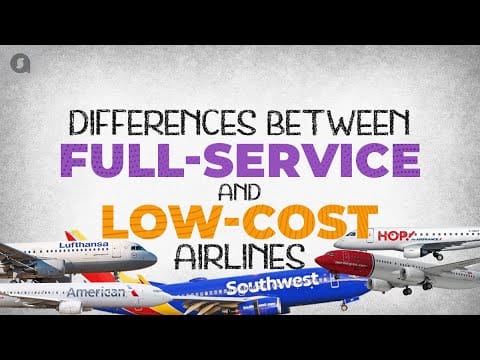

Watch how LLCs are different from FSCs
Full-service carriers
Full-service carriers (FSCs) are now following suit. In 2020, TAP Air Portugal launched Club TAP Miles&Go to complement their existing FFP. Subscribed club members could receive extra bonus miles for the annual fee.
In 2021, Emirates rolled out the Skywards+ membership program that gives benefits similar to their Skywards FFP – by paying a fee instead of earning loyalty status. The three subscription plans offer a range of perks starting with 20% ticket discounts and lounge access. This way, Emirates has guaranteed business even from non-frequent flyers.
Alaska Airlines subscription program Flight Pass allows members to book roundtrip tickets on eligible Alaska Airlines flights. With fees starting at $49 per month, this is a more niche product that mostly targets millennials/Gen Zs on the hunt for affordable travel between certain airports in California, Nevada, and Arizona.
Intermediaries: private jets and charters
On the other side of the spectrum lies private flying. Wheels Up is one of the companies that arrange private jet flights with initiation fees starting at $2,995 (up to $29,500). Membership gives access to reduced prices, last-minute booking options, personalized service, and a number of other perks including those from hotels and other partners. The program clearly targets a more high-end audience.
Other companies with similar offerings are Fly XO, Magellan Jets, VistaJet, etc.
Passengers subscribed to Surf Air get access to convenient charter flights from smaller airports that allow them to arrive 15 minutes before take-off and avoid the usual clearance hassle – a handy offering for last-minute corporate travelers. The membership fee is $295 per month with a number of add-ons available, e.g., unlimited flights for $1,900 a month.
Hotel and vacation rental subscriptions: from digital nomad packages to luxury vacationers
The hospitality industry, as we’ve described above, is home to all sorts of membership programs including vacation clubs, timeshares, and so on. That’s where the concept of subscriptions isn’t strictly defined and can overlap with other types of incentivizing plans.
For example, mycitizenM+ is a membership club within the citizenM hotel chain, offering 10 percent discounts on lodging and food, late checkouts, guaranteed rooms, and other perks for a monthly $12 fee.
Selina CoLive is another well-known trip subscription program for nomadic travelers (aka remote workers) that includes accommodation in the chain’s properties at preferred destinations, coworking space, wellness classes, on-site discounts, etc. Prices start from $330/month and depend on the location, season, and room type.
The vacation rental marketplace Zumper has recently launched a subscription membership program FlexPass that offers access to a database of short-term rental properties around the US for a $300 annual fee. To ensure a decent choice of listings, Zumper has partnered with such major players as Evolve and Rentals United. On the other hand, the biggest vacation rental industry players (Airbnb, Vrbo, Vacasa, etc.) don’t have subscription programs yet.
All of these programs are niche offerings mainly catering to the needs of digital nomads and remote workers with wanderlust.
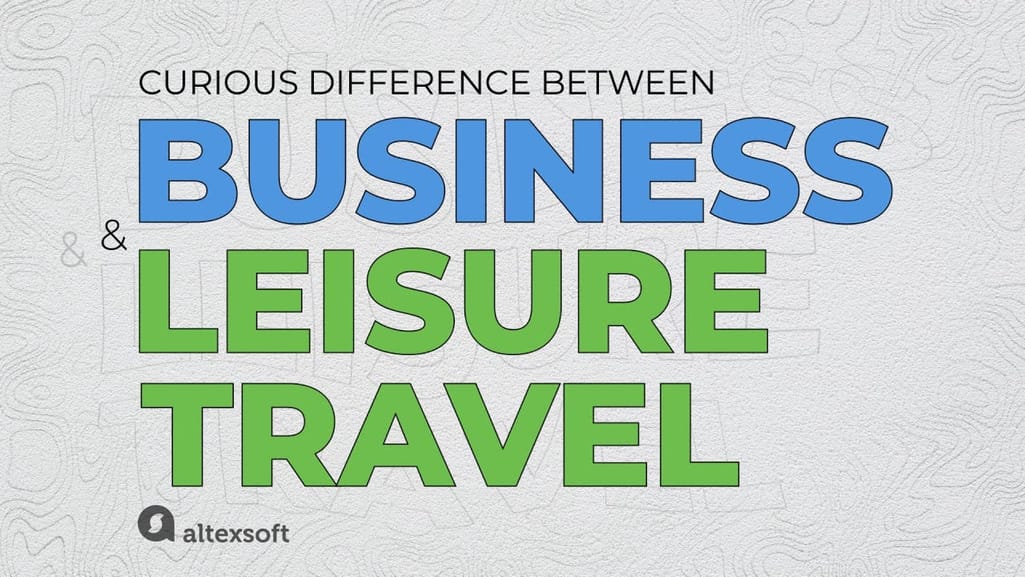

Watch how business travel is different from leisure and how the line blurs at times
On the opposite side sits Inspirato with its two types of luxury travel subscriptions:
- an Inspirato vacation club ($650/month plus $650 enrollment fee) that grants access to top-notch accommodation and
- an Inspirato Pass ($2,550/month plus $2,550 enrollment fee) with nightly rates, taxes, and fees for Pass trips included. This Pass enables booking luxury trips including vacation rentals, hotels and resorts, cruises, travel experiences, and so on. It also offers personalized service, pre-trip planning, on-site concierge, daily housekeeping, and a Beyond Travel discount program.
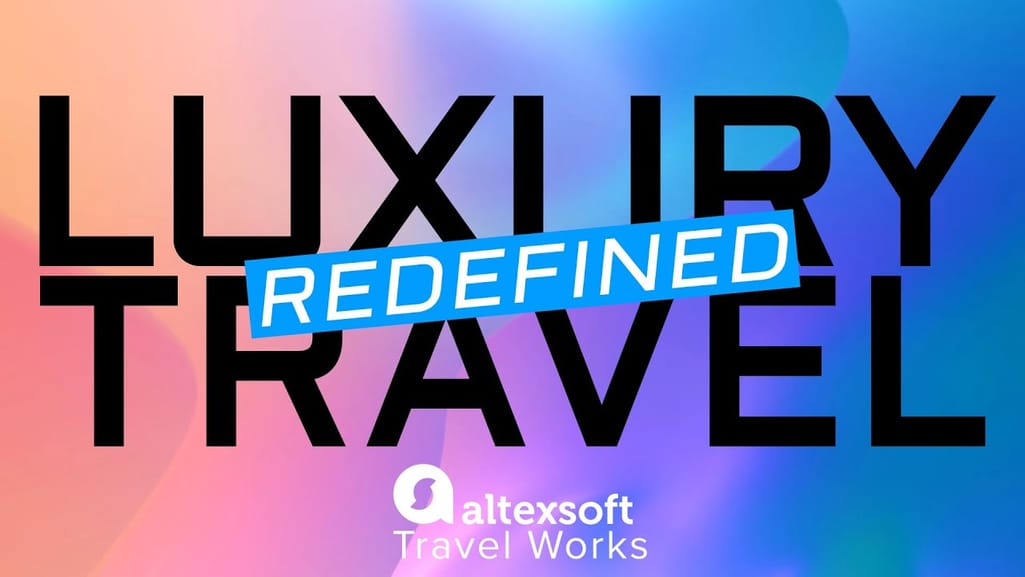

What to expect from luxury travel
Among hotel brands, loyalty programs are a typical reward scheme, so only a few embraced the subscription model. The InterContinental Ambassador is one example of such membership that basically allows travelers to buy loyalty status and all the related perks for $200 per year. Accor Plus is a similar offering that includes various discounts, elite loyalty program status, and even complimentary nights for its subscribers.
Such programs aim at driving direct bookings, building closer relationships with guests, increasing their loyalty, and reaching out to more potential customer groups such as business travelers from small and mid-size companies.
Travel distributors: discounts on various travel products
Another category of travel subscriptions includes travel resellers that offer discounts on their inventory.
For an annual $99 fee, TripAdvisor Plus provides access to discounted bookings on hotels and experiences plus additional perks like upgrades, spa credits, complimentary meals, etc. OTAs can also participate in this program and list their inventory, competing with hotels.
TripAdvisor Plus basically works as a reward program accruing cashback on the user’s account that can be used for future bookings.
eDreams ODIGEO, the largest online travel group in Europe and the largest distributor of online flights in the world, has three Prime subscription programs across its brands that allow travelers to save on flight, accommodation, packages, and car rentals.


eDreams ODIGEO overview
Its subscription model has proved to be extremely successful: In 2023, the number of Prime members was over 4.3 million. The company reported achieving an all-time record in bookings and revenues with the growing number of subscribers being the key factor of such outperformance. Also, the increasing number of Prime members who renew their subscriptions keeps delivering a predictable and sustainable revenue stream.
eDreams ODIGEO stays strong in its belief that subscription shopping is the future of travel retailing, expecting to reach 7.5 million subscribers by 2025 who will account for 66 percent of its total bookings.
Other travel subscriptions
In addition to the biggest categories we described, there are a lot of other travel-related businesses that operate on a subscription model.
Travel insurance and emergency evacuation service
Insurance is a subscription-based business -- no wonder it’s on our list. Travel insurance can be purchased for a single trip or as a recurrent subscription for multi-trip coverage. Depending on the package, it can cover health-related issues, cancellations, baggage emergencies, and more. Some global providers with a variety of subscription plans are Allianz Travel, Safety Wing, Seven Corners, and Staysure.
Some programs like Garmin Search and Rescue, Global Rescue, Medjet, and Ripcord are designed especially for adventure travelers and offer emergency evacuation services among other perks.
Access to attractions
Many cities have diverse tourist passes for their visitors. However, some passes offer longer, subscription-based options. For example, renewable Merlin passes provide access to 140 attractions in 24 countries around the world (price depends on the pass type), while the America the Beautiful Pass is an all-in-one ticket to more than 2,000 federal recreation sites for $80 per year.
Car rentals and other auto-related businesses
Lately, numerous car rental services have implemented a subscription model to give their customers more flexibility. Travelers can swap cars several times a month; plus insurance, roadside assistance, and maintenance are usually included. Monthly fees vary depending on the preferred type of car, insurance coverage, and other factors. For example, US drivers can join Hertz My Car, Sixt+, and Subscribe With Enterprise.
AAA (American Automobile Association) is North America’s biggest auto club, with a growing community of 60 million members. Besides roadside assistance and tow service, AAA members get auto repair discounts, parts and labor warranty, insurance, discounts from its partners like hotels or car rentals, etc. The subscription fee depends on the plan and area.
Good Sam is a global organization of RV owners that has a membership program offering discounts on campgrounds, fuel, and camping supplies, as well as other perks like trip planning service or roadside assistance.
How to launch a subscription program for a travel business
As you can see, there’s an endless variety of options on how to implement a subscription-based program into the travel business. While we can’t describe precise scenarios for each case, but we’ll provide a few general tips for you to consider.
Define your target audience. Subscription programs often cater to certain customer groups and/or offer niche products. Conduct thorough market research to clearly identify who you want to see as your key subscribers (e.g., millennial digital nomads or high-end family vacationers). That will also help you decide what you want to include in your program and how much to charge for it.
Choose the type of perks. Depending on your type of business, your subscription program's value proposition might include discounts (on your or your partners’ products), cashback, access to exclusive inventory, and so on. Check the examples of existing programs we’ve described and think about what you can offer to stand out.
Select the pricing approach. You might want to test several pricing methods (e.g., competitor-based, value-based, demand-based, etc.) before you come up with the optimal one. Think about making monthly and annual subscription options and multiple pricing tiers for different needs. You can also start off with free trials and other discounts as you attract customers, but remember to watch related churn.
Define rules and exceptions. Most subscription programs limit the booking window, have strict refund/cancelation policies, and so on. To avoid losing revenue in, say, high season, consider setting certain limitations such as blackout dates when inventory won't be available for discounted booking. Within the aviation sector, be sure to outline the baggage policy, ancillary pricing, etc.
Invest in marketing. Be ready for high marketing costs in the beginning as you spread the word about your new product. Use various tools including online and offline ads, social media campaigns, email newsletters, etc. Affiliate programs are another effective way to attract subscribers so consider partnering with influencers and popular travel online channels.
Create a partner network. As a part of your marketing program, you can also partner with such companies as credit card providers, mobile operators, big retail brands, etc. If they include your offering in their products, it will help increase customer reach. For example, the Target Circle loyalty program includes a complimentary TripAdvisor Plus membership.
Monitor churn and focus on retention. Customer churn is one of the most important KPIs for a subscription-based business. It basically shows how well it’s performing. Monitor it closely and prioritize retention strategies to minimize churn (e.g., increase personalization, create a constant communication/feedback loop, improve customer support, etc.).
Read about predicting customer churn with machine learning in our dedicated article.
Build a tech infrastructure and streamline user flow. To make your subscription work smoothly, you’ll have to invest in developing the technical infrasctructure. Again, it all depends on your type of business, but in any case, you’ll have to integrate the relevant business logic into your website, establish the payment flow, build an integration with your CRM, adjust your main customer interaction journey, and so on.
People today expect a seamless digital experience so having user-friendly web resources and convenient payment options is an absolute must. You might also want to create an app that will help users manage their subscriptions.
Be sure to check out AltexSoft’s expertise in implementing different payment scenarios for travel businesses and developing a cross-platform travel app.

Maria is a curious researcher, passionate about discovering how technologies change the world. She started her career in logistics but has dedicated the last five years to exploring travel tech, large travel businesses, and product management best practices.
Want to write an article for our blog? Read our requirements and guidelines to become a contributor.

